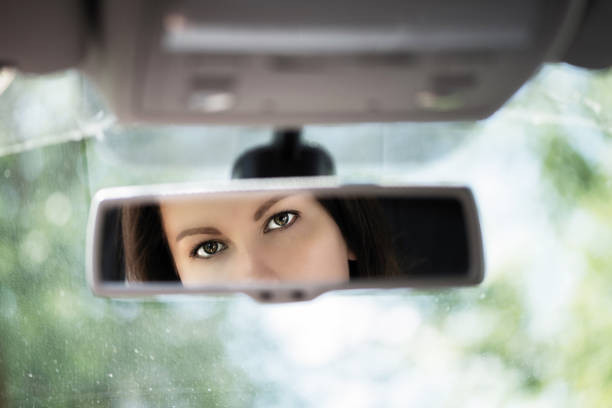The Importance of Mirror Use: How to Master the Three-Point Check
When it comes to safe driving, one of the most crucial skills you can develop is the effective use of your car’s mirrors. Whether you're navigating busy highways or making a simple lane change, properly using your mirrors ensures that you're aware of your surroundings and can react accordingly to potential hazards. At Get Drivers Ed, we place a strong emphasis on mirror use in our driver's ed courses because we know that mastering this skill can make all the difference in preventing accidents and staying safe on the road.
Why Mirror Use is Critical
Enhancing Situational Awareness
Driving is all about being aware of what's happening around you at all times. Your car's mirrors are essential tools that provide you with the information you need to make informed decisions on the road.
Rearview Mirror: This mirror gives you a clear view of what's directly behind your vehicle. It's crucial to check the road behind you before making any maneuvers, like changing lanes, braking, or backing up. It also helps you keep an eye on the behavior of drivers behind you, which can be crucial for avoiding rear-end collisions.
Side Mirrors: These mirrors allow you to see the lanes next to you, which is vital when merging or changing lanes. Proper adjustment and use of side mirrors can help you spot vehicles that may be in your blind spots. They’re also essential for checking the position of cyclists and pedestrians in urban environments.
Preventing Accidents
Many accidents occur because drivers fail to check their mirrors or don’t use them correctly. Proper mirror use helps you anticipate and avoid potential hazards.
Blind Spots: Every vehicle has blind spots—areas that aren't visible through your mirrors. These blind spots can hide vehicles, motorcycles, or even pedestrians. By using the three-point check, you can minimize the risk of missing a vehicle in your blind spot, thereby preventing accidents.
Lane Changes: Before changing lanes, it’s essential to check your mirrors and perform a quick shoulder check to ensure the lane is clear. This practice can prevent side-swipe collisions, which are common on multi-lane roads and highways..
How to Master the Three-Point Check
The three-point check is a technique that involves checking your mirrors and blind spots in a specific sequence to ensure you have a complete view of your surroundings before making a move. Here’s how to master it:
1. Check Your Rearview Mirror
Start by looking into your rearview mirror to see what's directly behind you. This gives you an overview of the traffic behind your vehicle and helps you gauge the distance of any approaching vehicles.
What to Look For: Pay attention to vehicles that are approaching quickly, maintaining a steady distance, or preparing to overtake you. Also, be aware of any vehicles that may be tailgating you or showing signs of aggressive driving.
When to Use: Check your rearview mirror frequently, especially when slowing down, stopping, or before making any turns. Regular checks help you stay informed about the flow of traffic behind you.
2. Check Your Side Mirrors
Next, glance at your side mirrors to see what's happening in the lanes beside you. This step is crucial for identifying vehicles that may be in your blind spots..
What to Look For: Look for vehicles in the lanes next to you, particularly those that might be moving at a similar speed or are close enough to pose a risk if you change lanes. Also, watch for motorcycles and bicycles, which can be harder to spot.
When to Use: Always check your side mirrors before merging, changing lanes, or making turns. Side mirrors give you a broader view of what's happening around your car, which is essential for safe maneuvering.
3. Perform a Shoulder Check
Finally, perform a quick shoulder check by turning your head to look over your shoulder in the direction you intend to move. This ensures there are no vehicles or obstacles in your blind spot.
What to Look For: Look for vehicles, motorcycles, bicycles, or pedestrians that may not be visible in your mirrors. This check confirms that the lane or space you’re moving into is clear.
When to Use: Always perform a shoulder check before changing lanes, merging, or entering a highway from an on-ramp. This last check is crucial because it covers the areas that mirrors can't, ensuring a complete view before you make any moves.
Common Mistakes to Avoid
Even experienced drivers can make mistakes when it comes to using mirrors. Here are some common errors and how to avoid them:
Over-Reliance on Mirrors: Some drivers rely solely on their mirrors and skip the shoulder check. This can be dangerous, as mirrors don't cover blind spots entirely. Always combine mirror checks with a shoulder check for maximum safety.
Incorrect Mirror Adjustment: Mirrors that aren't properly adjusted can create larger blind spots. Make sure your side mirrors are adjusted outward enough to minimize these blind spots and give you the widest possible view of the road.
Not Checking Mirrors Frequently: It’s important to check your mirrors regularly, not just when making a maneuver. Keeping an eye on your surroundings helps you anticipate potential hazards before they become immediate threats. Make it a habit to scan your mirrors every few seconds as you drive.
Conclusion
Mastering the three-point check and proper mirror use is essential for safe driving. At Get Drivers Ed, we teach our students the importance of these skills in our comprehensive driver's ed courses. By regularly checking your mirrors and performing shoulder checks, you can significantly reduce the risk of accidents and become a more confident, aware driver.
Ready to enhance your driving skills and learn more about safe driving practices? Enroll in our comprehensive online driver's ed program today. Let Get Drivers Ed guide you toward becoming a responsible and safe driver on the road.

